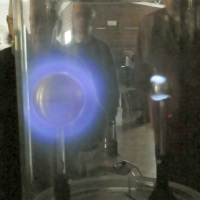Rings reign on Saturn

Tuesday 21st January 2014
 |
For our first talk of 2014 we were fortunate to have two speakers from Leicester University visiting us. In the first half of the evening we had Dr Henrik Melin talking about aurorae in the Solar System. He began by saying that aurorae have been discovered on many of the planets, and even moons, in our Solar System. Just like the aurora on Earth, extraterrestrial aurorae can form when particles in the solar wind are funnelled by a planet or moon's magnetic field until they abruptly hit the thicker layers of atmosphere. These high energy collisions with atmospheric molecules result in the release of light which we witness as an aurora.
However, it is not just the solar wind that can cause an aurora. One of the moons circling Jupiter, called Io, is close enough to the huge planet to be squashed and stretched as it orbits its parent planet. This stretching makes Io the most volcanic body in the Solar System and it constantly spews around a tonne of sulphur per second. Some of this material is charged and forms a torus (i.e. a doughnut-shaped ring) around Jupiter. This is then channelled into Jupiter's poles by Jupiter's magnetic field to produce a brighter auroral spot within the main auroral rings.
Io is not the only moon of Jupiter to cause auroral hotspots on Jupiter as Ganymede and Europa have also been shown to cause these atmospheric lightshows. Interestingly, these Jovian moons also have been observed by the Hubble Space Telescope to even have aurorae of their own.
With the exception of Mercury, nearly all of the planets in the Solar System have been discovered to have their own aurorae. Even Venus and Mars, which lack a global magnetic field, have been shown to have (respectively) diffuse or localised aurorae.
Dr Melin ended his section of the evening by saying that he was looking forward to the time when NASA's Juno spacecraft will reach Jupiter in 2016. One of its science goals is to map the structure of Jupiter's polar magnetic field and aurorae.
James O'Donoghue, who is studying for a doctorate at Leicester University, then carried on with the presentation. He is investigating the movement of water particles from Saturn's rings onto its atmosphere and estimates that about an Olympic-sized swimming pool of water falls onto the planet every day. However, this "rain" is more like a mist than an actual rain shower and it is not spread evenly over the whole planet.
Images from the Voyager spacecraft in the early 1980s had suggested that water could be moving from the rings to Saturn's atmosphere. The pictures showed only two to three dark bands but the later study, using the Keck telescopes on Hawaii and near-infrared imaging, has revealed more dark horizontal bands over more of the planet.
The research concludes that the pattern of dark bands matches the shape and structure of the rings almost exactly. Also, this infall of charged water particles along Saturn's magnetic field lines effectively quenches its ionosphere in these areas. James is hoping, along with his colleagues, to further study these phenomena using an instrument onboard NASA's Cassini spacecraft which is currently in orbit around Saturn.
This article was written for the club news column of the Stratford Herald. The actual lecture explained the subject at a deeper level.
